… at least when it comes to barre chords.
And really, I’m talking about one barre chord in particular.
Which one, you ask?
Why, one of “The Six Barre Chords“…. you know, the Magnificent Six, the Incredible Sextet, the Holy Trinity X 2 of Barre Chordness.
Perhaps I’m over-dramatizing this a tad. What I am really referring to is a group of what most everyday guitarists would deem as the most everyday barre chords…
(click image to enlarge)
I’m not entirely sure the rest of the guitar world thinks of these chords as a set, per se, but I’ve always addressed them as such. That’s because I operate under the premise that there are three chord families & this set of barre chords provides you with, not one, but two voicings from each family. This enables one to play a Major, Minor, or Dominant 7th chord in any key, in two different positions on the fretboard.
And this, mi amigo, enables you to play, I dunno…. maybe, like, over ten million songs!
But my intent today is to specifically address just one of these barre chords… henceforth referred to as “the Major barre chord with the root on the 5th string“.
You know… this guy…
It is the most incorrectly played chord in the universe.
Well, I might be edging on the overly dramatic thing again, but I deal with this chord all the time in my work with guitarists and very rarely does anyone approach this basic, yet important, staple of the barre chord society in a way that doesn’t create undo heartache. Maybe fingerache is a better word.
(yeah, I know… not a word)
Here’s the main thing- it‘s the only one of the six where you are NOT barring with your 1st finger. This voicing actually has you barring with your 3rd finger.
You see, with the other five barre chords, the first finger is doing all the heavy lifting, er, rather, heavy fretting?… I mean, it’s the one exerting the most effort because it is the finger that’s barring five or six strings. So that makes sense that one would naturally think they are suppose to barre strings 1 though 5 with the 1st finger. But this is where the “working too hard” part comes in.
Let’s break it down…
In playing the Major barre chord with the root on the 5th string, your 1st finger’s main job here is to hold down one note. You heard me… just one note. And that note is on the 5th string.
But while that’s the “main job”… there’s more job going on here.
Your 1st finger also needs to mute the 6th string and you do that with the tip of said 1st finger. And, it also has to mute the other four strings- 4, 3, 2, and 1.
Let’s have you take a stab at this right now… grab your guitar and put your first finger on the 5th string at the 3rd fret. That will put this barre chord in the key of C.
(You did that know that the root of this barre chord is on the 5th string & since you’re at the 3rd fret, that note is C and so the root of this chord is C, right?
Of course you did.)
Next, position your fingertip so that you are on the back of it somewhat and make sure you are touching the 6th string. Then make sure the back part of the rest of your finger is laying lightly, but not fretting, on strings 4, 3, 2, and 1.
Now slowly strum though each string, 6-1. You should hear: thump – C – thump – thump – thump – thump.
Strum through all the strings again…
thump – C – thump – thump – thump – thump.
Good job, 1st finger!
Here comes the fun part…
Take your 3rd finger and lay it across strings 4, 3 & 2 at the 5th fret. The trick here is to hold down those three strings but have the back of your 3rd finger rise up at the 1st string so that the 1st string is muted.
You are having fun, right? Because I just told you this was the “fun part.”
Now slowly strum though each string, 6-1. You should hear: thump – C – G – C – E – thump.
Here’s the part of the story where it becomes about “you’re working too hard“…
Do. Not. Barre. With. The. First. Finger.
If you do, you are wasting energy, my friend. (now in English) and energy is something you need to play a song full of barre chords.
This approach to this chord can take some getting used so please be patient with the process. As always, it starts with awareness and now that you are aware of how to efficiently & effectually play this chord, you just need to remember to remember to play it this way every time you use it.
Important!
With the 3rd finger barre, If you don’t rise up just so, you run the risk of fretting the 1st string at the 5th fret and then horrible, horrible things will happen.
Well, there I go being dramatic again. What actually will happen is that you will inadvertently fret the 1st string at the 5th fret & that will transform this majestic Major Triad into a Major 6 chord (because you’ve added the note A to the Major Triad).
And here’s the part of the story where this becomes the most “the most incorrectly played chord in the universe”. Because many many many guitarist go to play a major chord in their song using this barre chord and inadvertently play a Major 6 chord, where they meant to play a Major chord.
As it turns out, a Major 6 happens to be a very nice chord. And you should know & use this chord in your musical world.
But, like with all of your chords, you want to use it intentionally…. not by accident…. horrible accidents where one plays a chord one did not truly mean to play.
Truth be told, a Major 6th sounds nice & you could actually be improving the song at that point. But I want to make a strong statement here that it behooves you to be deliberate in the usages of your chord vocabulary. Don’t just go throwing Major 6 chords around willy-nillly, because sometimes it won’t sound okay, or it might be a musical situation where you need to be very specific with your chord choices.
And another thing…
Some people are naturally double-jointed and when they play this chord, their 3rd finger rise up off the fretboard, thus clearing the first string. What this means is you could actually then intentionally barre the first finger (I know I just told to not do that… give me a second) and get the note not the first string.
It would look like this…
Now in this case with adding a note, you’re cool- in as far as you are not changing the chord’s quality… it’s still a Major Triad. You’ve just added another chord tone – the 5th (music theory alert!) and all is hunky dory. It is now a fuller chord voicing since it now has five notes instead of four. It’s just that most people have trouble clearing the 1st string with their 3rd finger so it is traditionally played as the voicing & fingering of the chord we looked at above.
If you are one of those people that can do this, then have at it. But realize that that the whole story about “working too hard by barring when you don’t have to” goes away… because you now have to barre with your 1st finger… and your 3rd finger! But hey, having multiple ways to play the same chord is where it’s at in the world of the modern guitarist. There might be a time where your song absolutely needs to have this note on top & then you are ready.
Oh, wait… has anyone seen the 4th finger? Where has it been all this time?
Hopefully not behind the guitar neck! Yes, this happens to be a common hiding place for the 4th finger when it gets its feelings hurt due to not being a popular guest at this party. But seriously, you can damage your hand if you do this so please be aware of your smallest of digits & be nice to it.
Besides, the pinky will eventually get its day in the sun. You can always boost its self-esteem by giving it a significant role now & then by the playing of this chord… a Suspended 4th chord.
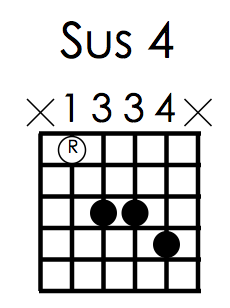
Have some fun going back & forth between the Major barre chord & this Suspended 4th chord while experimenting with different rhythms. You’ll no doubt feel you’ve heard this chord movement many times before. Hint: be careful not to impale you hand on your whammy bar while you’re doing windmills with your right arm.
(true story for… who?)
BTW, now you can play twenty million songs.
Your welcome.
Sorry to lay so many stories on you about just one chord but this is how it is sometimes in the world of creating music. Trust me, the fact that this chord is a daily chord warrants the attention.
I am still fascinated by so many things that happen when you combine humans & guitars. This chord is SO common yet so often misplayed.
I would suggest using this barre chord as a warm-up chord… at the beginning of your practice session you can just play it in a different few positions around the fretboard whilst paying close attention to all of the particulars addressed above. Make sure you strum all 6 stings to determine that all that strings that need to ring are ringing & all the strings that need to be muted are muted.
You are going to use this chord for the rest of you life so you may as well play it consistently accurate & with authority.
PS-
I wouldn’t be able to live with myself if I didn’t give you a heads-up some of these other Major barre chord with the root on the 5th string fingerings I often see people do…
(perfectly okay… but good-bye easy trip to Suspended 4th chord)
And then there’s this…
I guess you could say it’s a workaround to the need to deal with that finesse involved in the 3rd finger barre, although now you’ll need to barre the 1st finger, of course (which will make it just like the other five barre chords). And this chord is often mis-fingered so I want to make sure you do it in a way that works best… meaning, use 3 2 4, not 2 3 4.

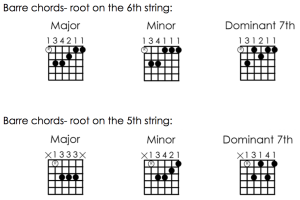
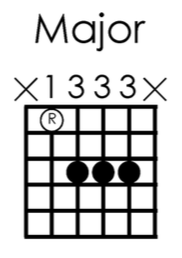
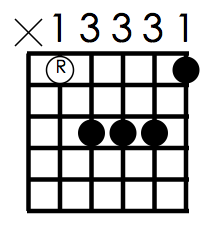
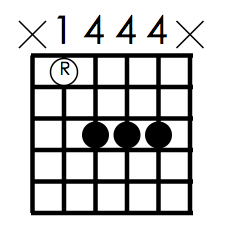
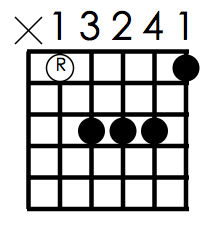


Leave A Response